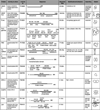Protein structure in context: the molecular landscape of angiogenesis
- PMID: 23868376
- PMCID: PMC4074543
- DOI: 10.1002/bmb.20706
Protein structure in context: the molecular landscape of angiogenesis
Abstract
A team of students, educators, and researchers has developed new materials to teach cell signaling within its cellular context. Two nontraditional modalities are employed: physical models, to explore the atomic details of several of the proteins in the angiogenesis signaling cascade, and illustrations of the proteins in their cellular environment, to give an intuitive understanding of the cellular context of the pathway. The experiences of the team underscore the use of these types of materials as an effective mode for fostering students' understanding of the molecular world and the scientific method used to define it.
Keywords: VEGF signaling; angiogenesis; protein structure; visual learning.
Copyright © 2013 Wiley Periodicals, Inc.
Figures







References
Publication types
MeSH terms
Substances
Grants and funding
LinkOut - more resources
Full Text Sources
Other Literature Sources

